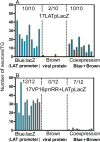De Novo Herpes Simplex Virus VP16 Expression Gates a Dynamic Programmatic Transition and Sets the Latent/Lytic Balance during Acute Infection in Trigeminal Ganglia
- PMID: 27607440
- PMCID: PMC5015900
- DOI: 10.1371/journal.ppat.1005877
De Novo Herpes Simplex Virus VP16 Expression Gates a Dynamic Programmatic Transition and Sets the Latent/Lytic Balance during Acute Infection in Trigeminal Ganglia
Abstract
The life long relationship between herpes simplex virus and its host hinges on the ability of the virus to aggressively replicate in epithelial cells at the site of infection and transport into the nervous system through axons innervating the infection site. Interaction between the virus and the sensory neuron represents a pivot point where largely unknown mechanisms lead to a latent or a lytic infection in the neuron. Regulation at this pivot point is critical for balancing two objectives, efficient widespread seeding of the nervous system and host survival. By combining genetic and in vivo in approaches, our studies reveal that the balance between latent and lytic programs is a process occurring early in the trigeminal ganglion. Unexpectedly, activation of the latent program precedes entry into the lytic program by 12 -14hrs. Importantly, at the individual neuronal level, the lytic program begins as a transition out of this acute stage latent program and this escape from the default latent program is regulated by de novo VP16 expression. Our findings support a model in which regulated de novo VP16 expression in the neuron mediates entry into the lytic cycle during the earliest stages of virus infection in vivo. These findings support the hypothesis that the loose association of VP16 with the viral tegument combined with sensory axon length and transport mechanisms serve to limit arrival of virion associated VP16 into neuronal nuclei favoring latency. Further, our findings point to specialized features of the VP16 promoter that control the de novo expression of VP16 in neurons and this regulation is a key component in setting the balance between lytic and latent infections in the nervous system.
Conflict of interest statement
The authors have declared that no competing interests exist.
Figures







Similar articles
-
Neuronal expression of herpes simplex virus-1 VP16 protein induces pseudorabies virus escape from silencing and reactivation.J Virol. 2024 Jul 23;98(7):e0056124. doi: 10.1128/jvi.00561-24. Epub 2024 Jun 13. J Virol. 2024. PMID: 38869285 Free PMC article.
-
Entry of herpes simplex virus type 1 (HSV-1) into the distal axons of trigeminal neurons favors the onset of nonproductive, silent infection.PLoS Pathog. 2012;8(5):e1002679. doi: 10.1371/journal.ppat.1002679. Epub 2012 May 10. PLoS Pathog. 2012. PMID: 22589716 Free PMC article.
-
Targeted Promoter Replacement Reveals That Herpes Simplex Virus Type-1 and 2 Specific VP16 Promoters Direct Distinct Rates of Entry Into the Lytic Program in Sensory Neurons in vivo.Front Microbiol. 2019 Jul 24;10:1624. doi: 10.3389/fmicb.2019.01624. eCollection 2019. Front Microbiol. 2019. PMID: 31396171 Free PMC article.
-
Alphaherpesvirus Latency and Reactivation with a Focus on Herpes Simplex Virus.Curr Issues Mol Biol. 2021;41:267-356. doi: 10.21775/cimb.041.267. Epub 2020 Sep 4. Curr Issues Mol Biol. 2021. PMID: 32883886 Review.
-
Herpes simplex virus latent infection in the nervous system.J Neurovirol. 1995 Mar;1(1):19-29. doi: 10.3109/13550289509111007. J Neurovirol. 1995. PMID: 9222339 Review.
Cited by
-
The Hippocampal Vulnerability to Herpes Simplex Virus Type I Infection: Relevance to Alzheimer's Disease and Memory Impairment.Front Cell Neurosci. 2021 Aug 13;15:695738. doi: 10.3389/fncel.2021.695738. eCollection 2021. Front Cell Neurosci. 2021. PMID: 34483839 Free PMC article. Review.
-
Impact of Cultured Neuron Models on α-Herpesvirus Latency Research.Viruses. 2022 Jun 2;14(6):1209. doi: 10.3390/v14061209. Viruses. 2022. PMID: 35746680 Free PMC article. Review.
-
Neuronal expression of herpes simplex virus-1 VP16 protein induces pseudorabies virus escape from silencing and reactivation.J Virol. 2024 Jul 23;98(7):e0056124. doi: 10.1128/jvi.00561-24. Epub 2024 Jun 13. J Virol. 2024. PMID: 38869285 Free PMC article.
-
Co-option of mitochondrial nucleic acid sensing pathways by HSV-1 UL12.5 for reactivation from latent Infection.bioRxiv [Preprint]. 2024 Jul 9:2024.07.06.601241. doi: 10.1101/2024.07.06.601241. bioRxiv. 2024. Update in: Proc Natl Acad Sci U S A. 2025 Jan 28;122(4):e2413965122. doi: 10.1073/pnas.2413965122. PMID: 39005440 Free PMC article. Updated. Preprint.
-
c-Jun signaling during initial HSV-1 infection modulates latency to enhance later reactivation in addition to directly promoting the progression to full reactivation.J Virol. 2024 Feb 20;98(2):e0176423. doi: 10.1128/jvi.01764-23. Epub 2024 Jan 9. J Virol. 2024. PMID: 38193709 Free PMC article.
References
-
- Weller SK (2011) Alphaherpesviruses Molecular Virology. 480 p.
-
- Dobson AT, Sederati F, Devi-Rao G, Flanagan WM, Farrell MJ, et al. (1989) Identification of the latency-associated transcript promoter by expression of rabbit beta-globin mRNA in mouse sensory nerve ganglia latently infected with a recombinant herpes simplex virus. J Virol 63: 3844–3851. - PMC - PubMed
-
- Margolis TP, Sedarati F, Dobson AT, Feldman LT, Stevens JG (1992) Pathways of viral gene expression during acute neuronal infection with HSV-1. Virology 189: 150–160. - PubMed
Publication types
MeSH terms
Substances
Grants and funding
LinkOut - more resources
Full Text Sources
Other Literature Sources
Medical

